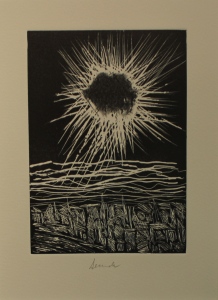August 24, 79 AD: Vesuvius erupts. Centuries after being dormant, the volcano explodes and takes the lives of thousands in Pompeii and Herculaneum. The devastation began at noon with a 10 mile cloud of ash and toxic fumes. This was followed by a flood of volcanic mud and rock that spread into the cities, burying the dead.
Although this was depressing, some beauty can be found as the area was “frozen in time” providing an archaeological record about the people who lived there.
The last eruption was in 1944 and another is expected in the near future.
Arthur created an entire portfolio on Vesuvius, which contains 15 original etchings. Here are two more images:




